PROJ6006: Leadership Styles in Project Management Analysis
VerifiedAdded on 2022/09/16
|8
|2102
|21
Case Study
AI Summary
This case study analyzes leadership approaches within the context of Acorn Industries, exploring how different leadership styles, such as transformational and situational leadership, can be applied to manage project teams effectively. It examines the use of various tools and techniques, including rewards, training, and communication strategies (emails, conferencing, SMS), to influence team performance and manage communication both within and outside the project group. The assignment delves into the application of different types of power to motivate team members, particularly focusing on reward power, and discusses methods for developing self-managed teams for agile projects. Furthermore, the case study outlines steps a project manager can take to address challenges, such as creating a challenges register, reporting promptly, assigning actions, monitoring progress, and consulting with stakeholders, before they negatively impact the work environment or the project's outcome. The analysis integrates insights from module resources and research to provide a comprehensive understanding of project management principles and practices.
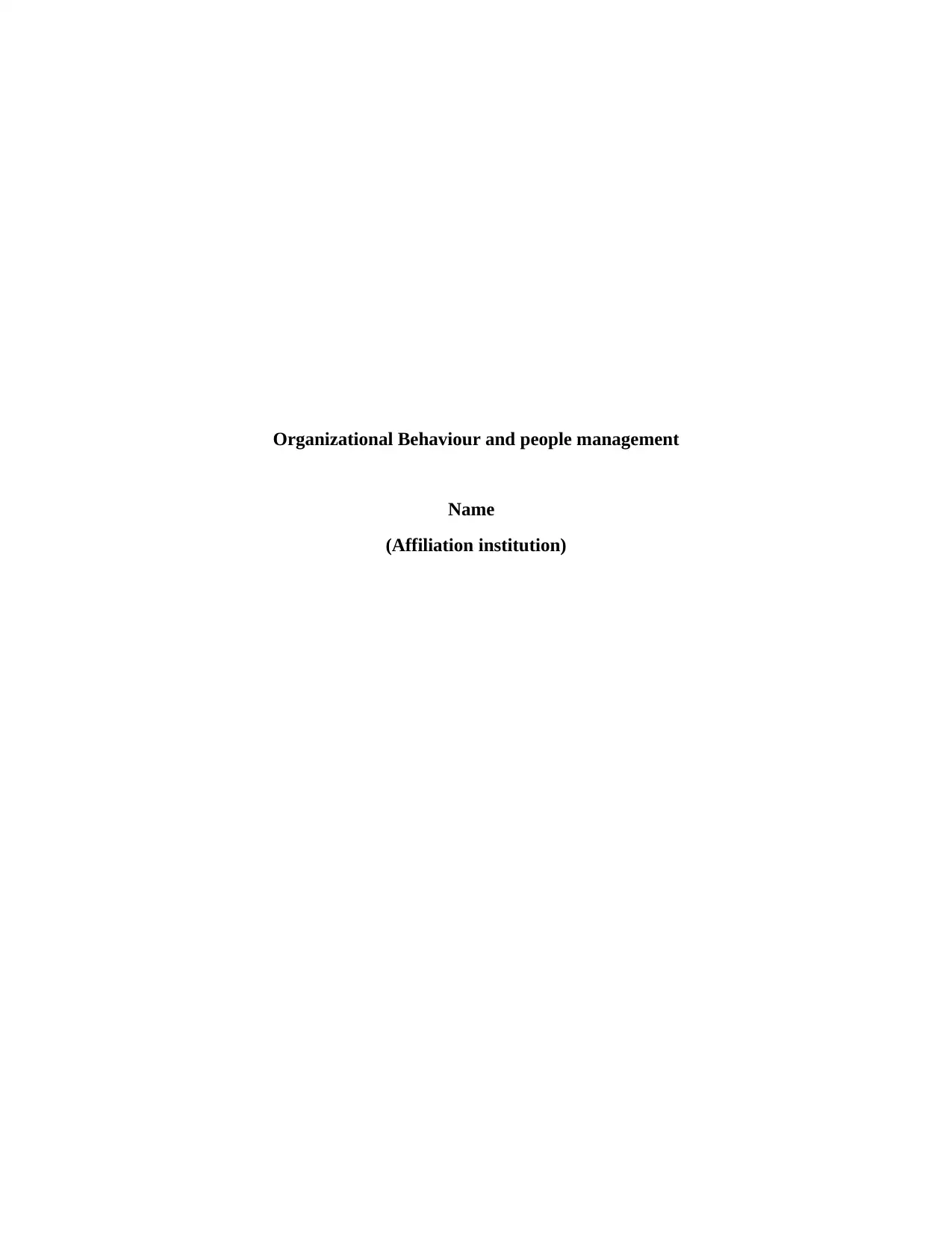
Organizational Behaviour and people management
Name
(Affiliation institution)
Name
(Affiliation institution)
Paraphrase This Document
Need a fresh take? Get an instant paraphrase of this document with our AI Paraphraser
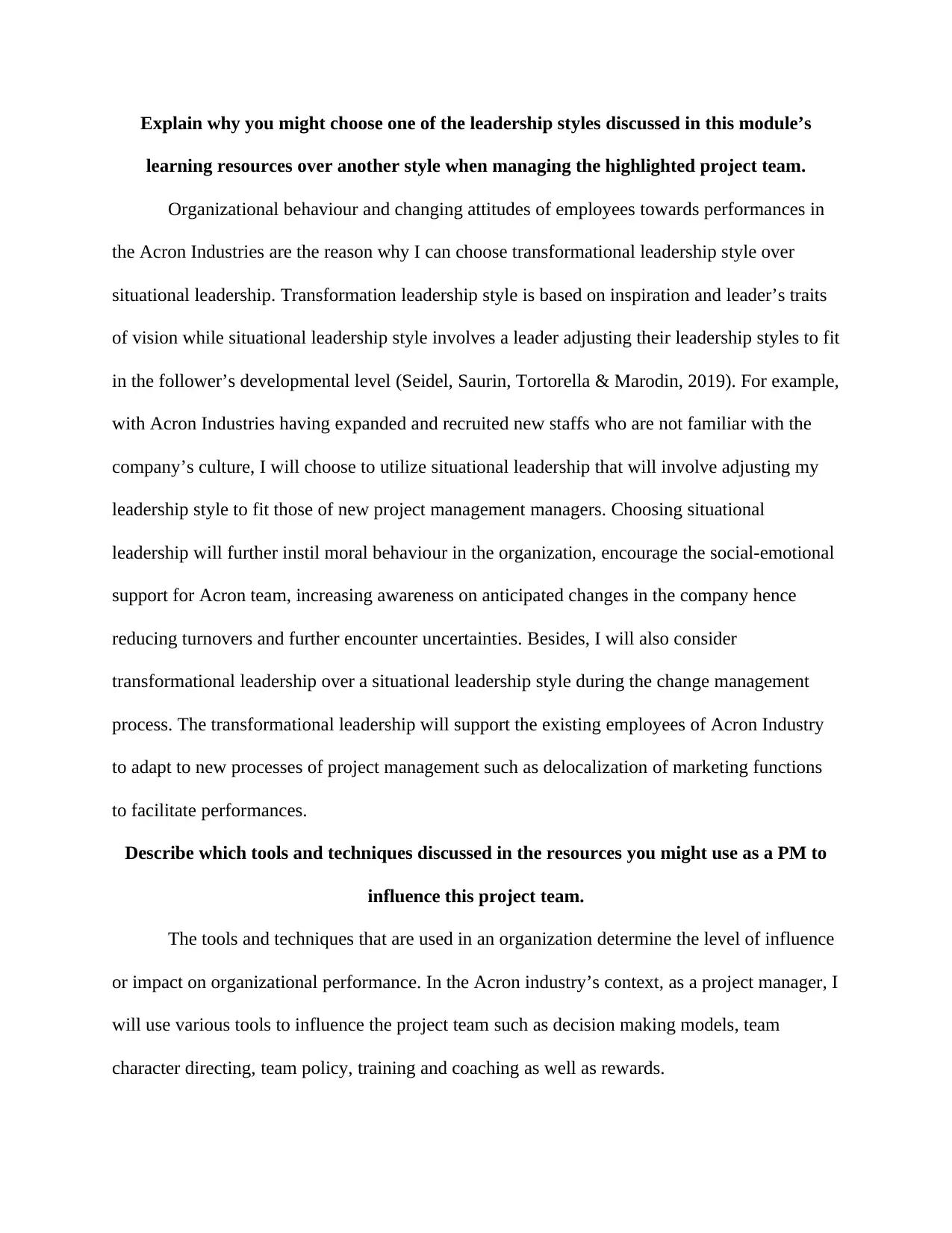
Explain why you might choose one of the leadership styles discussed in this module’s
learning resources over another style when managing the highlighted project team.
Organizational behaviour and changing attitudes of employees towards performances in
the Acron Industries are the reason why I can choose transformational leadership style over
situational leadership. Transformation leadership style is based on inspiration and leader’s traits
of vision while situational leadership style involves a leader adjusting their leadership styles to fit
in the follower’s developmental level (Seidel, Saurin, Tortorella & Marodin, 2019). For example,
with Acron Industries having expanded and recruited new staffs who are not familiar with the
company’s culture, I will choose to utilize situational leadership that will involve adjusting my
leadership style to fit those of new project management managers. Choosing situational
leadership will further instil moral behaviour in the organization, encourage the social-emotional
support for Acron team, increasing awareness on anticipated changes in the company hence
reducing turnovers and further encounter uncertainties. Besides, I will also consider
transformational leadership over a situational leadership style during the change management
process. The transformational leadership will support the existing employees of Acron Industry
to adapt to new processes of project management such as delocalization of marketing functions
to facilitate performances.
Describe which tools and techniques discussed in the resources you might use as a PM to
influence this project team.
The tools and techniques that are used in an organization determine the level of influence
or impact on organizational performance. In the Acron industry’s context, as a project manager, I
will use various tools to influence the project team such as decision making models, team
character directing, team policy, training and coaching as well as rewards.
learning resources over another style when managing the highlighted project team.
Organizational behaviour and changing attitudes of employees towards performances in
the Acron Industries are the reason why I can choose transformational leadership style over
situational leadership. Transformation leadership style is based on inspiration and leader’s traits
of vision while situational leadership style involves a leader adjusting their leadership styles to fit
in the follower’s developmental level (Seidel, Saurin, Tortorella & Marodin, 2019). For example,
with Acron Industries having expanded and recruited new staffs who are not familiar with the
company’s culture, I will choose to utilize situational leadership that will involve adjusting my
leadership style to fit those of new project management managers. Choosing situational
leadership will further instil moral behaviour in the organization, encourage the social-emotional
support for Acron team, increasing awareness on anticipated changes in the company hence
reducing turnovers and further encounter uncertainties. Besides, I will also consider
transformational leadership over a situational leadership style during the change management
process. The transformational leadership will support the existing employees of Acron Industry
to adapt to new processes of project management such as delocalization of marketing functions
to facilitate performances.
Describe which tools and techniques discussed in the resources you might use as a PM to
influence this project team.
The tools and techniques that are used in an organization determine the level of influence
or impact on organizational performance. In the Acron industry’s context, as a project manager, I
will use various tools to influence the project team such as decision making models, team
character directing, team policy, training and coaching as well as rewards.
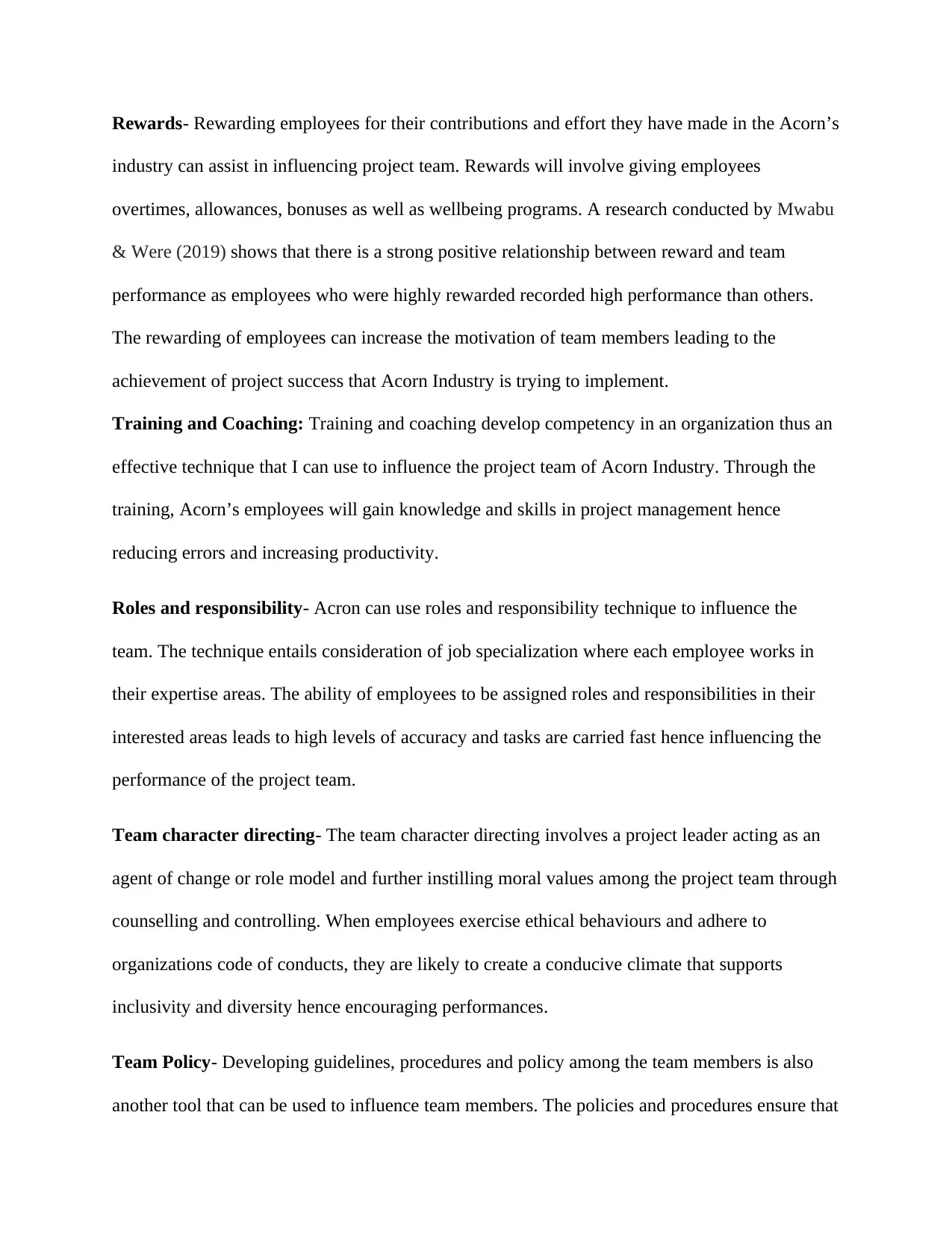
Rewards- Rewarding employees for their contributions and effort they have made in the Acorn’s
industry can assist in influencing project team. Rewards will involve giving employees
overtimes, allowances, bonuses as well as wellbeing programs. A research conducted by Mwabu
& Were (2019) shows that there is a strong positive relationship between reward and team
performance as employees who were highly rewarded recorded high performance than others.
The rewarding of employees can increase the motivation of team members leading to the
achievement of project success that Acorn Industry is trying to implement.
Training and Coaching: Training and coaching develop competency in an organization thus an
effective technique that I can use to influence the project team of Acorn Industry. Through the
training, Acorn’s employees will gain knowledge and skills in project management hence
reducing errors and increasing productivity.
Roles and responsibility- Acron can use roles and responsibility technique to influence the
team. The technique entails consideration of job specialization where each employee works in
their expertise areas. The ability of employees to be assigned roles and responsibilities in their
interested areas leads to high levels of accuracy and tasks are carried fast hence influencing the
performance of the project team.
Team character directing- The team character directing involves a project leader acting as an
agent of change or role model and further instilling moral values among the project team through
counselling and controlling. When employees exercise ethical behaviours and adhere to
organizations code of conducts, they are likely to create a conducive climate that supports
inclusivity and diversity hence encouraging performances.
Team Policy- Developing guidelines, procedures and policy among the team members is also
another tool that can be used to influence team members. The policies and procedures ensure that
industry can assist in influencing project team. Rewards will involve giving employees
overtimes, allowances, bonuses as well as wellbeing programs. A research conducted by Mwabu
& Were (2019) shows that there is a strong positive relationship between reward and team
performance as employees who were highly rewarded recorded high performance than others.
The rewarding of employees can increase the motivation of team members leading to the
achievement of project success that Acorn Industry is trying to implement.
Training and Coaching: Training and coaching develop competency in an organization thus an
effective technique that I can use to influence the project team of Acorn Industry. Through the
training, Acorn’s employees will gain knowledge and skills in project management hence
reducing errors and increasing productivity.
Roles and responsibility- Acron can use roles and responsibility technique to influence the
team. The technique entails consideration of job specialization where each employee works in
their expertise areas. The ability of employees to be assigned roles and responsibilities in their
interested areas leads to high levels of accuracy and tasks are carried fast hence influencing the
performance of the project team.
Team character directing- The team character directing involves a project leader acting as an
agent of change or role model and further instilling moral values among the project team through
counselling and controlling. When employees exercise ethical behaviours and adhere to
organizations code of conducts, they are likely to create a conducive climate that supports
inclusivity and diversity hence encouraging performances.
Team Policy- Developing guidelines, procedures and policy among the team members is also
another tool that can be used to influence team members. The policies and procedures ensure that
⊘ This is a preview!⊘
Do you want full access?
Subscribe today to unlock all pages.

Trusted by 1+ million students worldwide
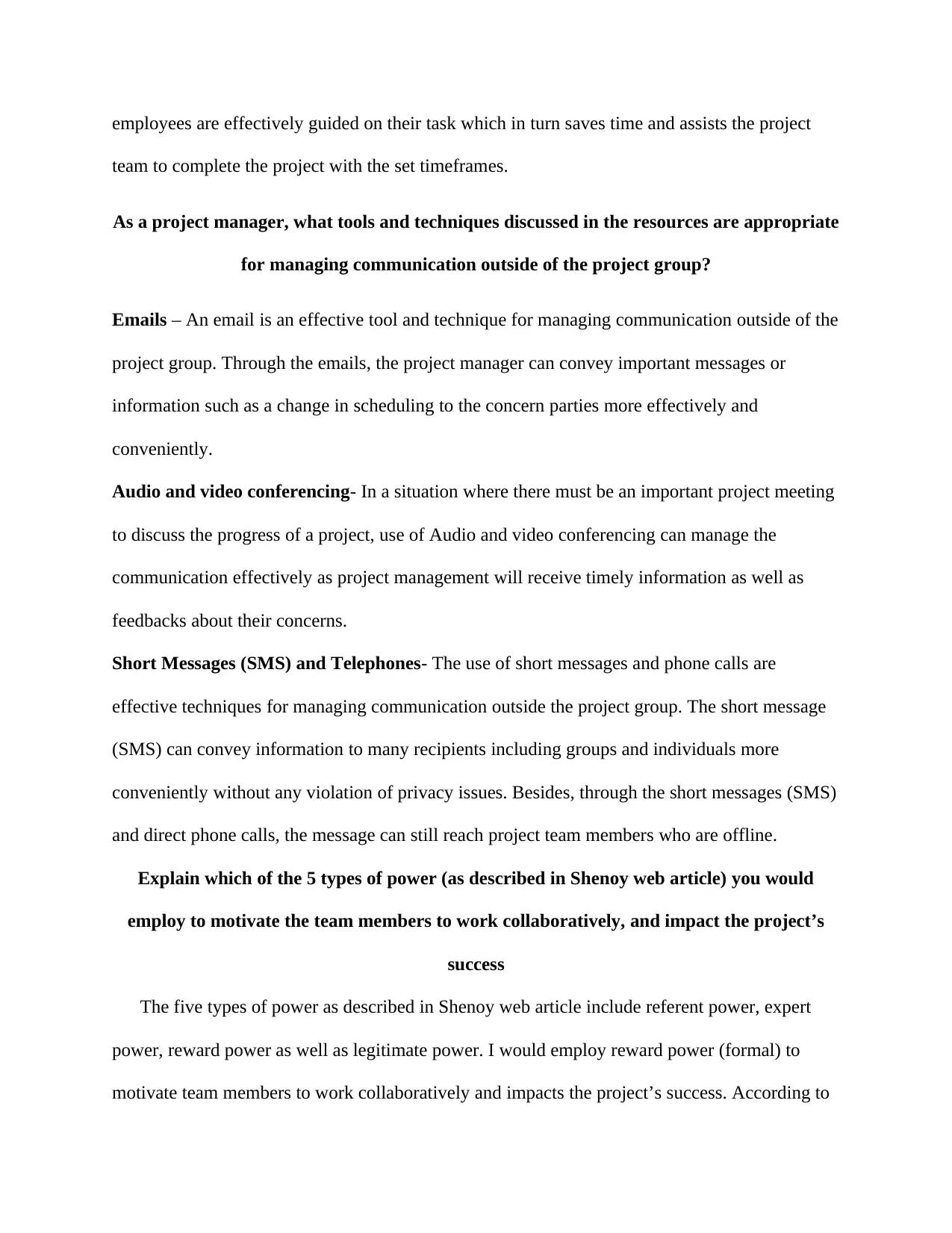
employees are effectively guided on their task which in turn saves time and assists the project
team to complete the project with the set timeframes.
As a project manager, what tools and techniques discussed in the resources are appropriate
for managing communication outside of the project group?
Emails – An email is an effective tool and technique for managing communication outside of the
project group. Through the emails, the project manager can convey important messages or
information such as a change in scheduling to the concern parties more effectively and
conveniently.
Audio and video conferencing- In a situation where there must be an important project meeting
to discuss the progress of a project, use of Audio and video conferencing can manage the
communication effectively as project management will receive timely information as well as
feedbacks about their concerns.
Short Messages (SMS) and Telephones- The use of short messages and phone calls are
effective techniques for managing communication outside the project group. The short message
(SMS) can convey information to many recipients including groups and individuals more
conveniently without any violation of privacy issues. Besides, through the short messages (SMS)
and direct phone calls, the message can still reach project team members who are offline.
Explain which of the 5 types of power (as described in Shenoy web article) you would
employ to motivate the team members to work collaboratively, and impact the project’s
success
The five types of power as described in Shenoy web article include referent power, expert
power, reward power as well as legitimate power. I would employ reward power (formal) to
motivate team members to work collaboratively and impacts the project’s success. According to
team to complete the project with the set timeframes.
As a project manager, what tools and techniques discussed in the resources are appropriate
for managing communication outside of the project group?
Emails – An email is an effective tool and technique for managing communication outside of the
project group. Through the emails, the project manager can convey important messages or
information such as a change in scheduling to the concern parties more effectively and
conveniently.
Audio and video conferencing- In a situation where there must be an important project meeting
to discuss the progress of a project, use of Audio and video conferencing can manage the
communication effectively as project management will receive timely information as well as
feedbacks about their concerns.
Short Messages (SMS) and Telephones- The use of short messages and phone calls are
effective techniques for managing communication outside the project group. The short message
(SMS) can convey information to many recipients including groups and individuals more
conveniently without any violation of privacy issues. Besides, through the short messages (SMS)
and direct phone calls, the message can still reach project team members who are offline.
Explain which of the 5 types of power (as described in Shenoy web article) you would
employ to motivate the team members to work collaboratively, and impact the project’s
success
The five types of power as described in Shenoy web article include referent power, expert
power, reward power as well as legitimate power. I would employ reward power (formal) to
motivate team members to work collaboratively and impacts the project’s success. According to
Paraphrase This Document
Need a fresh take? Get an instant paraphrase of this document with our AI Paraphraser
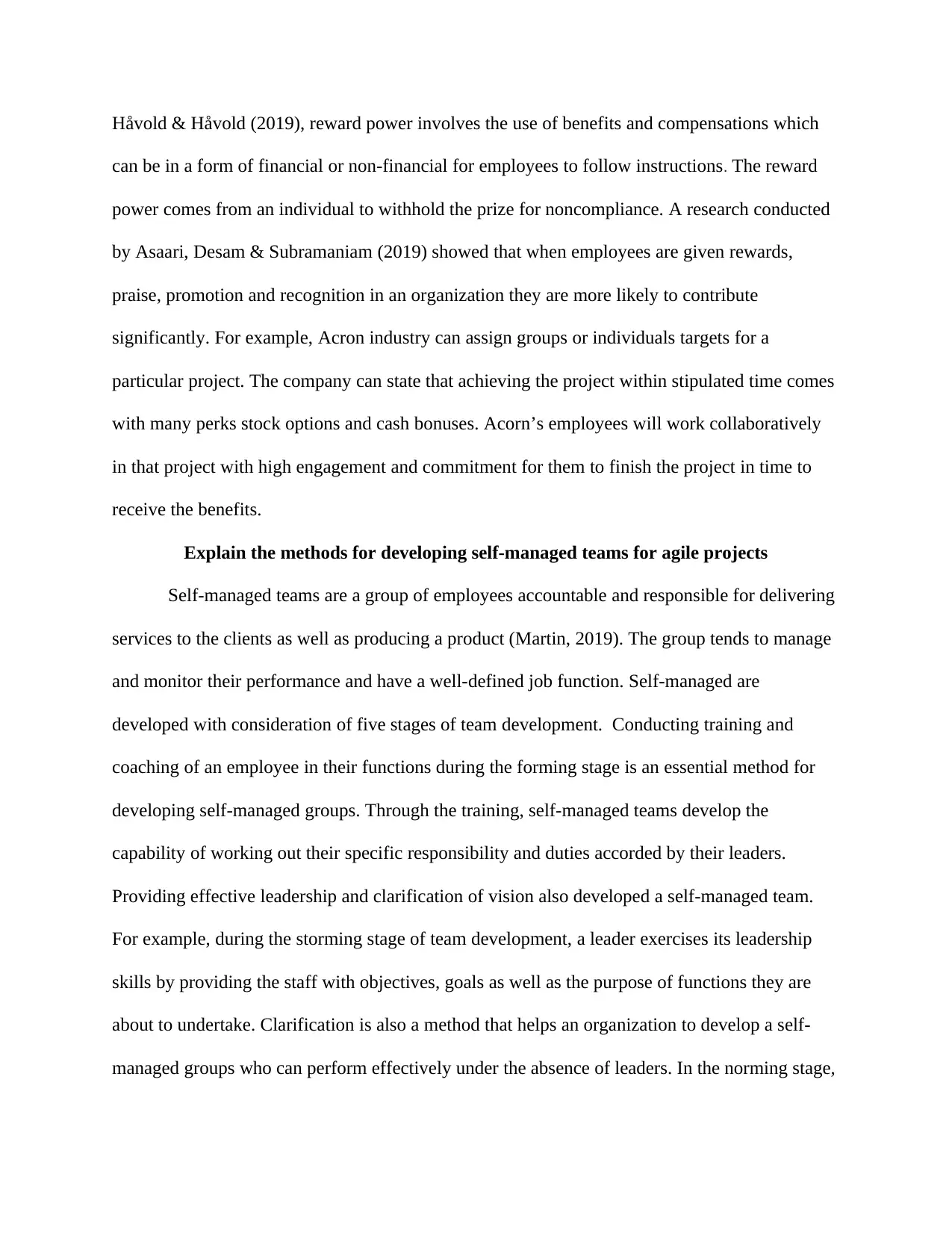
Håvold & Håvold (2019), reward power involves the use of benefits and compensations which
can be in a form of financial or non-financial for employees to follow instructions. The reward
power comes from an individual to withhold the prize for noncompliance. A research conducted
by Asaari, Desam & Subramaniam (2019) showed that when employees are given rewards,
praise, promotion and recognition in an organization they are more likely to contribute
significantly. For example, Acron industry can assign groups or individuals targets for a
particular project. The company can state that achieving the project within stipulated time comes
with many perks stock options and cash bonuses. Acorn’s employees will work collaboratively
in that project with high engagement and commitment for them to finish the project in time to
receive the benefits.
Explain the methods for developing self-managed teams for agile projects
Self-managed teams are a group of employees accountable and responsible for delivering
services to the clients as well as producing a product (Martin, 2019). The group tends to manage
and monitor their performance and have a well-defined job function. Self-managed are
developed with consideration of five stages of team development. Conducting training and
coaching of an employee in their functions during the forming stage is an essential method for
developing self-managed groups. Through the training, self-managed teams develop the
capability of working out their specific responsibility and duties accorded by their leaders.
Providing effective leadership and clarification of vision also developed a self-managed team.
For example, during the storming stage of team development, a leader exercises its leadership
skills by providing the staff with objectives, goals as well as the purpose of functions they are
about to undertake. Clarification is also a method that helps an organization to develop a self-
managed groups who can perform effectively under the absence of leaders. In the norming stage,
can be in a form of financial or non-financial for employees to follow instructions. The reward
power comes from an individual to withhold the prize for noncompliance. A research conducted
by Asaari, Desam & Subramaniam (2019) showed that when employees are given rewards,
praise, promotion and recognition in an organization they are more likely to contribute
significantly. For example, Acron industry can assign groups or individuals targets for a
particular project. The company can state that achieving the project within stipulated time comes
with many perks stock options and cash bonuses. Acorn’s employees will work collaboratively
in that project with high engagement and commitment for them to finish the project in time to
receive the benefits.
Explain the methods for developing self-managed teams for agile projects
Self-managed teams are a group of employees accountable and responsible for delivering
services to the clients as well as producing a product (Martin, 2019). The group tends to manage
and monitor their performance and have a well-defined job function. Self-managed are
developed with consideration of five stages of team development. Conducting training and
coaching of an employee in their functions during the forming stage is an essential method for
developing self-managed groups. Through the training, self-managed teams develop the
capability of working out their specific responsibility and duties accorded by their leaders.
Providing effective leadership and clarification of vision also developed a self-managed team.
For example, during the storming stage of team development, a leader exercises its leadership
skills by providing the staff with objectives, goals as well as the purpose of functions they are
about to undertake. Clarification is also a method that helps an organization to develop a self-
managed groups who can perform effectively under the absence of leaders. In the norming stage,
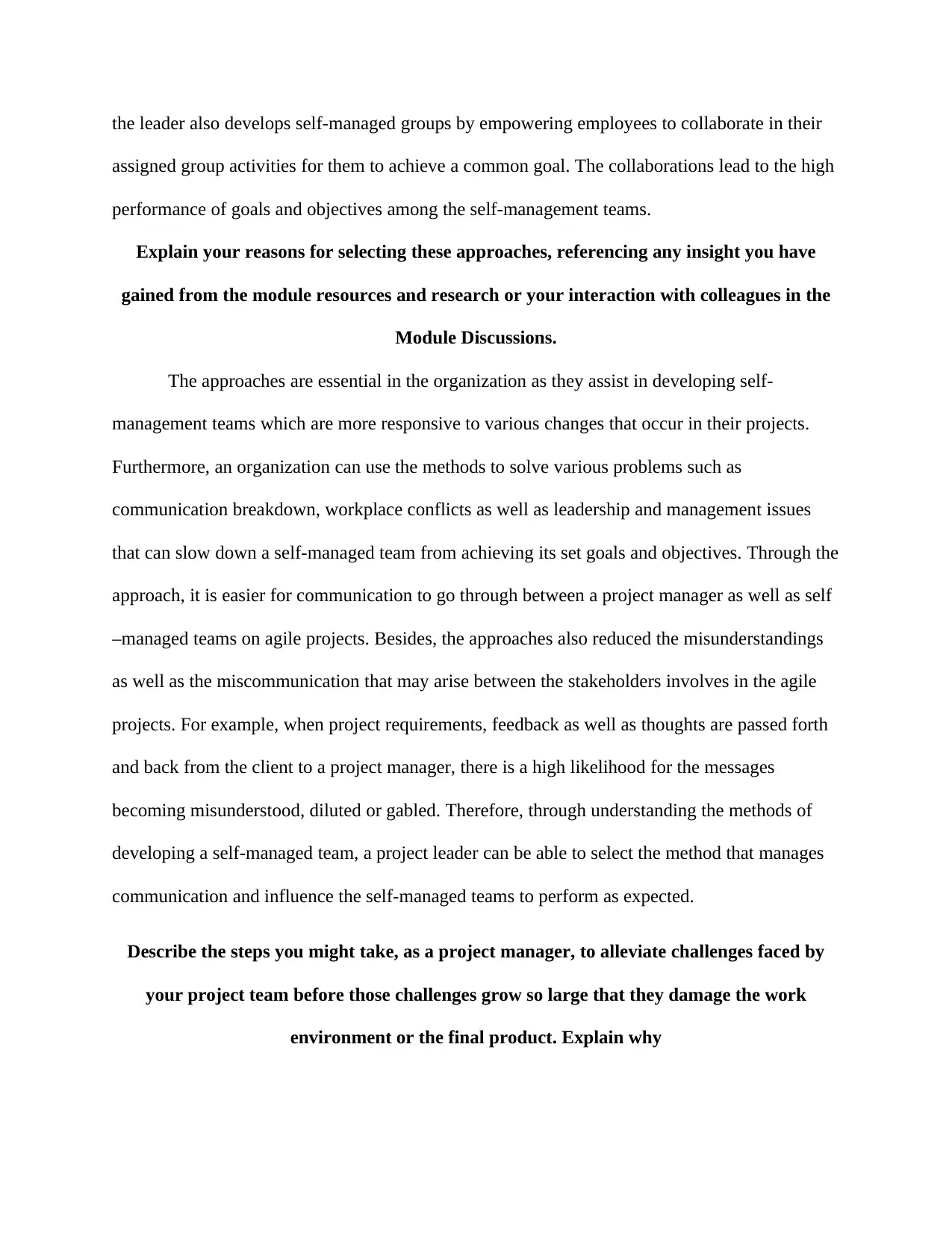
the leader also develops self-managed groups by empowering employees to collaborate in their
assigned group activities for them to achieve a common goal. The collaborations lead to the high
performance of goals and objectives among the self-management teams.
Explain your reasons for selecting these approaches, referencing any insight you have
gained from the module resources and research or your interaction with colleagues in the
Module Discussions.
The approaches are essential in the organization as they assist in developing self-
management teams which are more responsive to various changes that occur in their projects.
Furthermore, an organization can use the methods to solve various problems such as
communication breakdown, workplace conflicts as well as leadership and management issues
that can slow down a self-managed team from achieving its set goals and objectives. Through the
approach, it is easier for communication to go through between a project manager as well as self
–managed teams on agile projects. Besides, the approaches also reduced the misunderstandings
as well as the miscommunication that may arise between the stakeholders involves in the agile
projects. For example, when project requirements, feedback as well as thoughts are passed forth
and back from the client to a project manager, there is a high likelihood for the messages
becoming misunderstood, diluted or gabled. Therefore, through understanding the methods of
developing a self-managed team, a project leader can be able to select the method that manages
communication and influence the self-managed teams to perform as expected.
Describe the steps you might take, as a project manager, to alleviate challenges faced by
your project team before those challenges grow so large that they damage the work
environment or the final product. Explain why
assigned group activities for them to achieve a common goal. The collaborations lead to the high
performance of goals and objectives among the self-management teams.
Explain your reasons for selecting these approaches, referencing any insight you have
gained from the module resources and research or your interaction with colleagues in the
Module Discussions.
The approaches are essential in the organization as they assist in developing self-
management teams which are more responsive to various changes that occur in their projects.
Furthermore, an organization can use the methods to solve various problems such as
communication breakdown, workplace conflicts as well as leadership and management issues
that can slow down a self-managed team from achieving its set goals and objectives. Through the
approach, it is easier for communication to go through between a project manager as well as self
–managed teams on agile projects. Besides, the approaches also reduced the misunderstandings
as well as the miscommunication that may arise between the stakeholders involves in the agile
projects. For example, when project requirements, feedback as well as thoughts are passed forth
and back from the client to a project manager, there is a high likelihood for the messages
becoming misunderstood, diluted or gabled. Therefore, through understanding the methods of
developing a self-managed team, a project leader can be able to select the method that manages
communication and influence the self-managed teams to perform as expected.
Describe the steps you might take, as a project manager, to alleviate challenges faced by
your project team before those challenges grow so large that they damage the work
environment or the final product. Explain why
⊘ This is a preview!⊘
Do you want full access?
Subscribe today to unlock all pages.

Trusted by 1+ million students worldwide
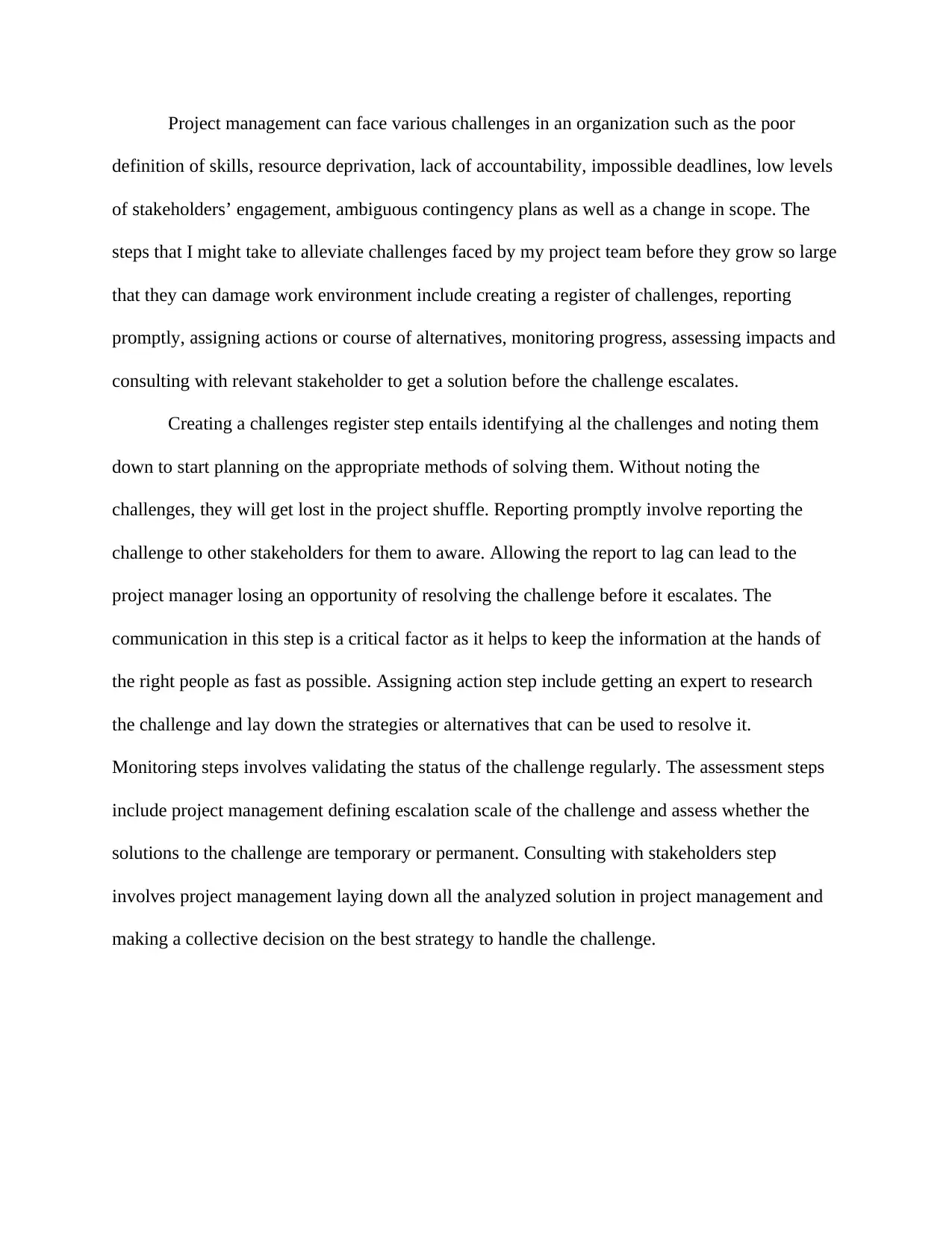
Project management can face various challenges in an organization such as the poor
definition of skills, resource deprivation, lack of accountability, impossible deadlines, low levels
of stakeholders’ engagement, ambiguous contingency plans as well as a change in scope. The
steps that I might take to alleviate challenges faced by my project team before they grow so large
that they can damage work environment include creating a register of challenges, reporting
promptly, assigning actions or course of alternatives, monitoring progress, assessing impacts and
consulting with relevant stakeholder to get a solution before the challenge escalates.
Creating a challenges register step entails identifying al the challenges and noting them
down to start planning on the appropriate methods of solving them. Without noting the
challenges, they will get lost in the project shuffle. Reporting promptly involve reporting the
challenge to other stakeholders for them to aware. Allowing the report to lag can lead to the
project manager losing an opportunity of resolving the challenge before it escalates. The
communication in this step is a critical factor as it helps to keep the information at the hands of
the right people as fast as possible. Assigning action step include getting an expert to research
the challenge and lay down the strategies or alternatives that can be used to resolve it.
Monitoring steps involves validating the status of the challenge regularly. The assessment steps
include project management defining escalation scale of the challenge and assess whether the
solutions to the challenge are temporary or permanent. Consulting with stakeholders step
involves project management laying down all the analyzed solution in project management and
making a collective decision on the best strategy to handle the challenge.
definition of skills, resource deprivation, lack of accountability, impossible deadlines, low levels
of stakeholders’ engagement, ambiguous contingency plans as well as a change in scope. The
steps that I might take to alleviate challenges faced by my project team before they grow so large
that they can damage work environment include creating a register of challenges, reporting
promptly, assigning actions or course of alternatives, monitoring progress, assessing impacts and
consulting with relevant stakeholder to get a solution before the challenge escalates.
Creating a challenges register step entails identifying al the challenges and noting them
down to start planning on the appropriate methods of solving them. Without noting the
challenges, they will get lost in the project shuffle. Reporting promptly involve reporting the
challenge to other stakeholders for them to aware. Allowing the report to lag can lead to the
project manager losing an opportunity of resolving the challenge before it escalates. The
communication in this step is a critical factor as it helps to keep the information at the hands of
the right people as fast as possible. Assigning action step include getting an expert to research
the challenge and lay down the strategies or alternatives that can be used to resolve it.
Monitoring steps involves validating the status of the challenge regularly. The assessment steps
include project management defining escalation scale of the challenge and assess whether the
solutions to the challenge are temporary or permanent. Consulting with stakeholders step
involves project management laying down all the analyzed solution in project management and
making a collective decision on the best strategy to handle the challenge.
Paraphrase This Document
Need a fresh take? Get an instant paraphrase of this document with our AI Paraphraser
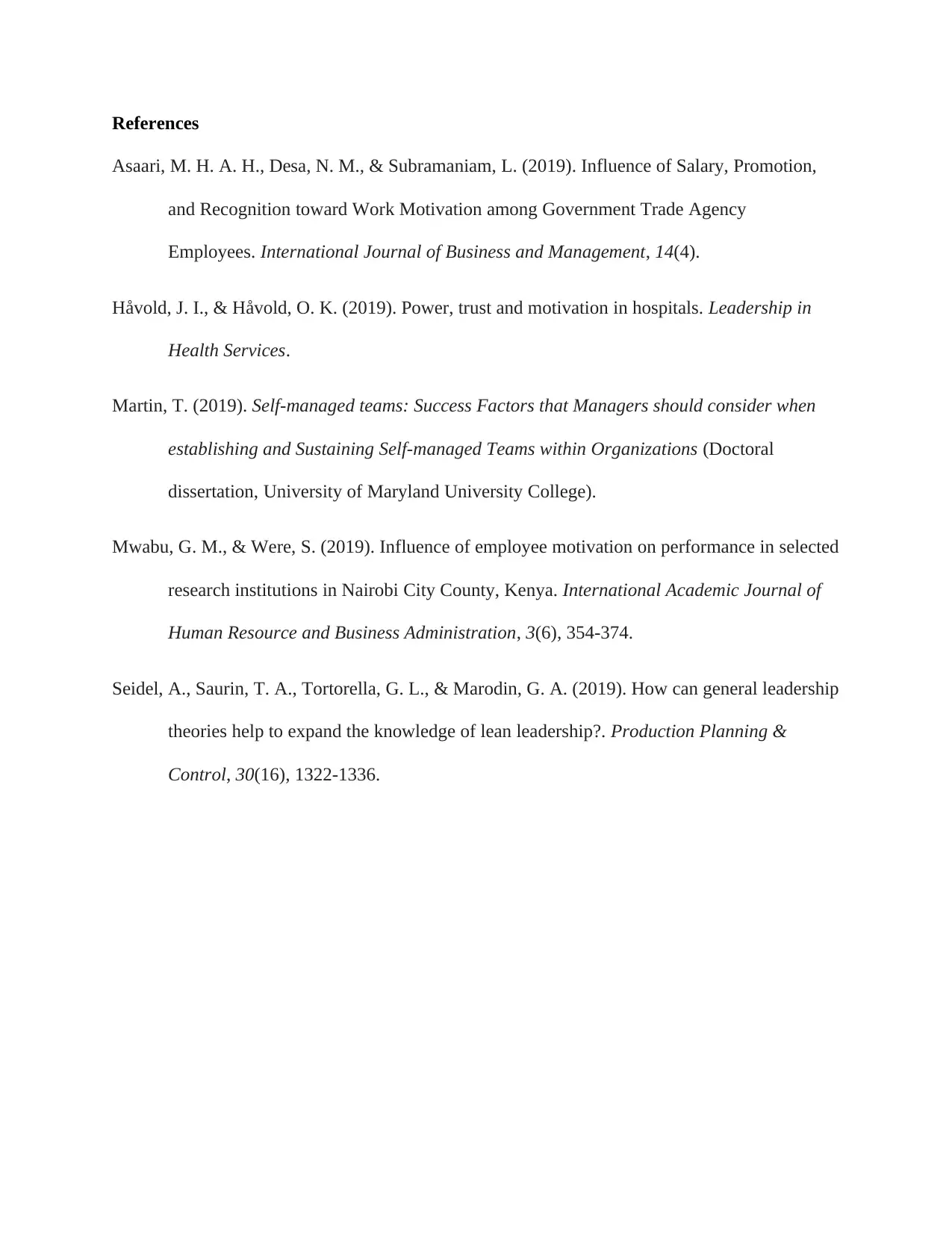
References
Asaari, M. H. A. H., Desa, N. M., & Subramaniam, L. (2019). Influence of Salary, Promotion,
and Recognition toward Work Motivation among Government Trade Agency
Employees. International Journal of Business and Management, 14(4).
Håvold, J. I., & Håvold, O. K. (2019). Power, trust and motivation in hospitals. Leadership in
Health Services.
Martin, T. (2019). Self-managed teams: Success Factors that Managers should consider when
establishing and Sustaining Self-managed Teams within Organizations (Doctoral
dissertation, University of Maryland University College).
Mwabu, G. M., & Were, S. (2019). Influence of employee motivation on performance in selected
research institutions in Nairobi City County, Kenya. International Academic Journal of
Human Resource and Business Administration, 3(6), 354-374.
Seidel, A., Saurin, T. A., Tortorella, G. L., & Marodin, G. A. (2019). How can general leadership
theories help to expand the knowledge of lean leadership?. Production Planning &
Control, 30(16), 1322-1336.
Asaari, M. H. A. H., Desa, N. M., & Subramaniam, L. (2019). Influence of Salary, Promotion,
and Recognition toward Work Motivation among Government Trade Agency
Employees. International Journal of Business and Management, 14(4).
Håvold, J. I., & Håvold, O. K. (2019). Power, trust and motivation in hospitals. Leadership in
Health Services.
Martin, T. (2019). Self-managed teams: Success Factors that Managers should consider when
establishing and Sustaining Self-managed Teams within Organizations (Doctoral
dissertation, University of Maryland University College).
Mwabu, G. M., & Were, S. (2019). Influence of employee motivation on performance in selected
research institutions in Nairobi City County, Kenya. International Academic Journal of
Human Resource and Business Administration, 3(6), 354-374.
Seidel, A., Saurin, T. A., Tortorella, G. L., & Marodin, G. A. (2019). How can general leadership
theories help to expand the knowledge of lean leadership?. Production Planning &
Control, 30(16), 1322-1336.
1 out of 8
Related Documents
Your All-in-One AI-Powered Toolkit for Academic Success.
+13062052269
info@desklib.com
Available 24*7 on WhatsApp / Email
![[object Object]](/_next/static/media/star-bottom.7253800d.svg)
Unlock your academic potential
Copyright © 2020–2025 A2Z Services. All Rights Reserved. Developed and managed by ZUCOL.




